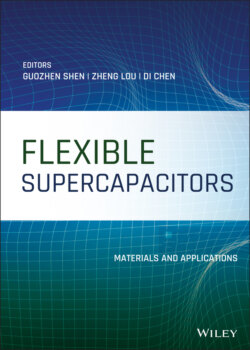Читать книгу Flexible Supercapacitors - Группа авторов - Страница 34
2.2.2.2 Omnidirectionally Stretchable Planar SCs
ОглавлениеFrom the aforementioned stretchable actions, it can be concluded that stretchability can be realized without affecting on the electrochemical performances of the SCs. There are even some operations with enhanced electrochemical performance when the SCs devices was stretched due to the more contact between electrode and gel electrolyte under stretching. Unfortunately, these actions can only be stretched along one direction, hence, if it is possible to make SCs isotropic stretchable, the electrochemical performance, such as specific capacitance, cycle stability etc. also could be improved in a certain degree.
Figure 2.6 (a) Fabrication process of the stretchable SCs by buckling electrode materials on an elastomeric PDMS substrate. (b) SEM image of a buckled CNT macro film. (c) CV profiles of the stretchable SCs measured at 30% strain.
Source: Reproduced with permission [64]. © 2009, Wiley‐VCH.
(d) Schematics of the stretchable SCs fabrication. (e) CV curves of the stretchable SCs at different tensile strains.
Source: Reproduced with permission [65]. © 2014, The Royal Society of Chemistry.
In 2016, Yu et al. designed a novel isotropic wavy shaped CNT film electrode based omnidirectionally stretchable SCs, as shown in Figure 2.7 [66]. Figure 2.7a showed the fabrication process. In detail, the PDMS elastic film was uniformly pre‐strained in all direction, and then CNT film was transformed to the PDMS substrate, finally, after relaxation, the omnidirectionally stretchable SCs were assembled. The SEM images of side view of buckled CNT film on silicon rubber substrate were presented in Figure 2.7b. The buckled CNT film and tight connection will benefit the stretchability. Figure 2.7c demonstrated the excellent isotropic stretchability of the buckled CNT film. The resistance variation after 10 000 uniaxially stretching−releasing cycles was also measured (Figure 2.7d), which showed a little increase (< 3%) at tensile strains of 200%. Figure 2.7e displayed the CV curves of the fabricated SCs with various deformable states. No significant change was observed in the CVs with 200% applied omnidirectional strains. Moreover, the specific area capacitance was improved from 1160.43 to 1230.61 mF cm−2 during uniaxial, biaxial, and omnidirectional elongations, which showed wide potential application in stretchable electronics.
Figure 2.7 (a) Schematic illustration of steps for fabricating omnidirectionally stretchable SC. (b) SEM image of the buckled CNT film. (c) Photos of buckled CNT film under various deformations. (d) Normalized electrical resistance of the stretchable SC under stretching−releasing cycles at a strain of 200%. (e) CV curves of the fabricated SC at various stretching states.
Source: Reproduced with permission [66]. © 2016, American Chemical Society.
